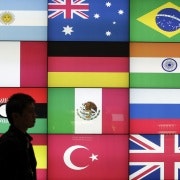Solar's bounce off trade barriers
The October 10 ruling by the US Department of Commerce against PV modules containing Chinese-produced solar cells is just the most recent development in a string of trade disputes that stretch across the globe.
Until now, much of the discussion has focused on the details of each case, the potential effect on different manufacturers, technology types, etcetera.
But perhaps the bigger question is how these issues collectively will affect the main issue confronting the PV industry today: the supply/demand imbalance.
Supply/demand issues are not simply confined to upstream (manufacturer stock levels) and downstream (warehouse/distributor) inventory levels. They are currently affecting excess polysilicon supply and (perhaps most profoundly) wafer oversupply that is anywhere in the 5-10 GW level.
In terms of end-market demand, the PV industry has been growing rapidly. Over the five-year period from 2007 to 2011, downstream module demand increased by an annual compound average growth rate of over 50 per cent. This growth in downstream demand has certainly been matched by growth in module manufacturing capacity – with the scale of growth here during 2010 and 2011 being the key factor in price erosion over the past 12-18 months.
In 2006, total module capacity exceeded total module demand by almost 2.5. This implies that, for every PV module that was needed for an installation, there was enough capacity to satisfy more than double that amount. By 2011 the ratio had declined somewhat, but was still slightly over two, showing a continued environment of oversupply. Indeed, nameplate capacity of production equipment delivered during 2010 and 2011 would have supplied a 60 GW industry in 2012, twice the level currently being forecast for this year.
Between the end of 2008 and the end of 2011, PV module inventories held by module manufacturers increased more than seven-fold. Much of the increase in capacity can be attributed to the rise of Tier 2 and 3 Chinese manufacturers and not necessarily the Tier 1 (pure-play PV) Chinese companies that are currently feeling the full effect of anti-dumping tariffs. Indeed, many of the Tier 2 and 3 Chinese manufacturers are currently retreating to their original businesses, and may simply write off any PV investments undertaken during 2010 and 2011.
Therefore, it would appear to be the rise of these Tier 2 and Tier 3 Chinese PV companies that has led Western manufacturers to lodge trade complaints, alleging unfair competition and subsidisation on the part of the Chinese government. (Solarbuzz highlighted this topic in 2010.)
As summarised in the table, there are four ongoing trade investigations concerning PV products (with several more in the works).
Although each of these investigations differs slightly in terms of the ‘target' regions/countries and industry segments, there does appear to be an underlying theme: domestic manufacturers alleging unfair subsidization of imports and requesting additional charges to increase domestic competitiveness. While each dispute may ultimately have a somewhat ‘localised' effect, the bigger question is how they will affect the global PV supply/demand balance.
These actions may actually have a positive effect in terms of industry rationalisation (bringing total production and production capacity more in line with actual demand). This could be achieved by imposing additional costs on Tier 2 and 3 manufacturers that may not be able to alter supply arrangements to avoid local duties and thus will simply become uncompetitive.
As the US and EU complaints have already shown, sophisticated players, regardless of nationality, can find a way to avoid otherwise harmful taxes. This can be achieved by altering supply chains, such as Chinese module producers using non-Chinese cells for US-bound products; or through defensive acquisitions, such as Hanwha SolarOne purchasing Q-Cells to maintain access to European markets. Less well-funded competitors are unlikely to have the resources to pursue such strategies and may find themselves locked out of end-market opportunities.
Also, the trade disputes may create increased geographic fragmentation of lower tier manufacturers because they will be required to ship their products across a wider range of territories. Indeed, small-scale PV manufacturers already exist (and thrive) in many markets, in particular within emerging PV regions. Many of these manufacturing entities are actually a direct result of government policies or joint-ventures that promote domestic manufacturing.
Investigations resulting in increased tariffs or the exclusion of foreign products (in favor of domestically produced goods) may help stimulate more domestic PV module manufacturing. Then, the goal of these companies would be to ‘right-size' local manufacturing facilities to meet domestic needs with the understanding that any excess production in that facility is unlikely to be consumed by foreign PV markets. This outcome could possibly soften the decline of module prices, due to lack of domestic competition.
Regardless of the scenarios that may unfold, the PV industry must evolve to a stage where a considerable quantity of PV capacity is removed from the supply chain, from polysilicon through modules. The first stage of this process has already begun, with many Western manufacturers entering receivership. The next wave of closures is likely to involve uncompetitive Chinese manufacturers that are not ‘chosen' as suitable candidates for continued support from local banks. Indeed, this process had already begun prior to any trade investigations being completed.
The next few quarters should provide more insights into how fast PV industry rationalisation will take place, as the full effect of trade disputes become more apparent.
This article was originally published by SolarBuzz. Republished with permission.













